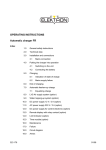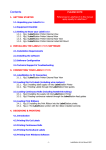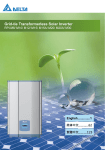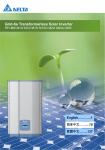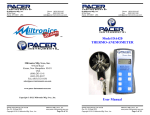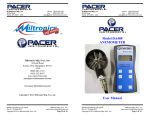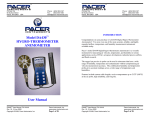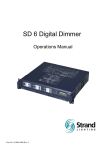Download SERVICE MANUAL
Transcript
AXIgo TRACTION BATTERY CHARGER SERVICE MANUAL 4 5093 00 3 AXIgo TRACTION BATTERY CHARGER Content 1 1.1 1.2 1.3 1.4 1.5 1.6 1.7 1.8 2 2.1 2.2 2.3 3 3.1 3.2 4 5 5.1 5.2 6 7 8 Basic Data .............................................................................................................. 2 Device Characteristics .............................................................................................. 2 Usage ...................................................................................................................... 2 The Marking System of the AXIgo-type chargers ...................................................... 2 Standards ................................................................................................................. 2 Operational Safety ................................................................................................... 2 Supplies and Storage ............................................................................................... 3 Service ..................................................................................................................... 3 Abbreviations used ................................................................................................... 3 Technical Characteristics ....................................................................................... 4 Technical Specifications ............................................................................................ 4 Installation of the Charger ........................................................................................ 5 Description of Charger Control and Signalling .......................................................... 6 Setting of the Charger ...................................................................................... 6 Setting of the Output Current and the Selection of the Charging Characteristics ...... 6 How to Find Out the Current Setting ....................................................................... 7 Charger Functions, Charging Procedure ............................................................. 8 Standard Charging ............................................................................................... 9 IUIa Characteristic .................................................................................................... 9 IUa Characteristic .................................................................................................... 10 Battery Regeneration Mode ................................................................................. 10 Charger Maintenance ............................................................................................ 11 Alarm signalling .................................................................................................... 11 4 5093 00 3 1 1 Basic data 1.1 Device characteristics The AXIgo-type chargers are intended for industrial applications, mainly for charging traction batteries for electric high lift trucks and manipulation and cleaning technology devices. With regard to the perfect electric parameters, they are suitable even for different types of batteries (e.g. maintenance-free batteries, gel batteries, AGM etc.). The whole model range is shown in the Chart 1. The rated (maximum) charging current is in the range of 25 – 200A. The standard output voltage is 12 – 96V, a different one on request. The respective types enable to set the output current in a step operation in the range of c. 50-100% Inom. The AXIgo chargers use the principles of high-frequency technology. They are based on power units operating in a high switching frequency, with the efficiency of up to 94 %. The charging is either a one-phase one, or a three-phase one. The charging process is controlled by a microprocessor control system. Important statuses are indicated by indicator lamps. According to their dimensions, the AXIgo chargers are installed into three types of boxes – S, M, L (see chapt. 2.1) 1.2 Usage The chargers are designed to be used in interiors with standard conditions (humidity, temperature, dustiness). When operated in a place with a higher level of dustiness, the interval of service inspections must be shortened. They should be connected to one-phase or three-phase power mains with a standard moveable lead cable with a three-pole or a four-pole connector. The suitable protection must be carried out in the installation of the charging station. They are intended for cycle charging of traction batteries and they can be continuously operated. Cooling is provided by fans placed inside the charger. 1.3 The marking system of the AXIgo-type chargers AXIgo aa-bb aa rated output voltage, types 24, 36, 48, 72, 80, 96V bb rated output current 25-200A Examples of the marking: AXIgo 24-30 voltage 24V, current 30A, box S AXIgo 48-50 voltage 48V, current 50A, box M AXIgo 80-55 voltage 80V, current 55A, box L 1.4 Standards The AXIgo chargers meets the requirements of the following standards: EN 60950-1: Information Technology Equipment - Safety EN 61000-6-2: EMC – Immunity for Industrial Environments EN 61000-6-4: EMC – Emission Standard for Industrial Environments CSN 33 2000-4-41: Electrical Devices - Safety 1.5 Operational safety The following requirements must be met during the operation of the chargers: - during the charging process, the chargers must be placed in well-ventilated rooms; - the chargers must be connected only to the standard power mains; - it is necessary to avoid sparking and making a fire near the battery; explosion hazard during the process of charging; 4 5093 00 3 2 - the chargers must not be operated without a cover, an electric shock hazard - only batteries intended for charging with the parameters (voltage, capacity ranges) suitable for the specified type of charger can be charged; - during charging, it is dangerous to touch the supply leads to the battery poles; - the transport of the charger during the charging process is prohibited; - the supply leads to the battery must not be disconnected during the process of charging; - the charger can be operated only by a respectively qualified person - any changes in parameters can be made only by an authorized technical engineer. 1.6 Supplies and storage The charger is supplied in a completed condition, with Operating Instructions. Normally it is supplied without connectors (except for the 1-phase power supply) with the 2m-long outgoing cables. A functional test is carried out with every charger. The charger must be transported in the original package, the position during the transport can be arbitrary. It is permitted to store the chargers in roofed, dry rooms, with the temperature from -25 °C to +80 °C, relative humidity up to 95 %, non-condensing. 1.7 Service If a fault of the charger occurs, contact your retailer. On no account should the charger be repaired on your own. The service of the chargers is provided by AXIMA, spol. s r.o., Vídeňská 125, 619 00 Brno, Czech Republic. 1.8 Abbreviations used Ah Cnom Inom Ichar Unom 4 5093 00 3 ampere hour rated battery capacity rated current of the charger set current at the top of the charging characteristics, in the range of 2,00 - 2,4V/cell rated charging voltage 3 2 Technical characteristics 2.1 Technical specifications Table of types AXIgo type Nom. input Max. outvoltage (V) put current (A) Mains (VAC) ** Input current (A) External protection (A)* Case Weight (kg) 12-30 12 30 230 1,7 6 S 3,7 12-60 12 60 230 3,5 6 M 6,6 24-30 24 30 230 3,5 6 S 3,7 24-60 24 60 230 7,2 10 M 6,6 24-100 24 100 3x400 4 6 M 8,8 24-200 24 200 3x400 8 10 L 17,0 36-30 36 30 230 5,4 10 M 6,6 36-55 36 55 3x400 3,3 6 M 8,8 36-110 36 110 3x400 6,6 10 L 17,0 36-165 36 165 3x400 9,9 16 XL 26,0 48-30 48 30 230 7,2 10 M 6,6 48-50 48 50 3x400 4 6 M 8,8 48-100 48 100 3x400 8 10 L 17,0 48-150 48 150 3x400 12 16 XL 26,0 72-27 72 27 3x400 3,2 6 M 8,8 72-55 72 55 3x400 6,6 10 L 17,0 72-80 72 80 3x400 9,9 16 XL 26,0 80-27 80 27 3x400 3,6 6 M 8,8 80-55 80 55 3x400 7,3 10 L 17,0 80-80 80 80 3x400 10,8 16 XL 26,0 96-25 96 25 3x400 4 6 M 8,8 96-50 96 50 3x400 8 10 L 17,0 96-75 96 75 3x400 12 16 XL 26,0 * External protection - circuit breaker char. C nebo D ** Mains tolerance +15% -10%, 1phase chargers ± 15%. Charasterictic Starting current <10 A, 0,1 ms Efficiency ≤ 94% Output voltage stability ± 1% Output current stability ± 2% Protection IP20 Protection class I Pollution Class 2 Cooling forced ventilation Working environment -10 to +40 °C, max. rel. humidity 95%, non-condensing Standards, EMC, LVD ČSN EN 61000-6-4, ČSN EN 61000-6-2, ČSN EN 60950-1, 4,2 kV I/O 4 5093 00 3 4 Dimensions of chargers Case/Dimensions (mm) S M L XL Width 172 mm 245 mm 252 mm 252 mm Height 232 mm 349 mm 383 mm 434 mm Depth 89 mm 93 mm 169 mm 245 mm Mounting by 4 screws Ø5 (X x Y) 110 x 265 mm 110 x 375 mm 110 x 410 mm 110 x 465 mm Colour of the box is standard black or arbitrary at customer‘s request 2.2 Installation of the charger The box of the AXIgo chargers is intended to be hung on the wall (on a stand or on a bracket) in the vertical working position. Fastening should be carried out by means of wood screws with the diameter of 5-8mm. However, the charger may be operated in the horizontal position, laid on its rear side, on a table or a base etc. To secure the correct functioning of the charger, it is necessary to keep the distance of at least 100 mm on both the sides of the charger as well as on the front side from other devices in order to provide sufficient ventilation. The slots for air suction must not be covered. With regard to the possibility of dust suction, the placement of the device on the floor or in a low position above the floor is not suitable. If the charger is operated in the environment with a high dust level, the interval between service inspections and cleaning procedures must be shortened. Possible damage or destruction of the charger due to heavy dusting during the duration of guarantee means breach of the conditions of guarantee and therefore the device will not be subject to the guarantee repair. The charger is equipped with a three-conductor lead 3 PE, in a one-phase design with a three-conductor lead 1 N PE ex-factory. It should be connected to the power mains by means of the respective four-pin (fivepin) or three-pin plug. The socket for the connection must be protected with a suitable circuit breaker. Cables for battery connection are conducted from the charger outlet. The positive outlet is indicated by red colour, whereas the negative outlet is coloured blue or it does not have any colouring. Voltage dropping in these cables is taken into consideration during the process of charging. In order to avoid the change in charging parameters, it is forbidden to adjust the length of the outgoing cables. Further it is necessary to provide the operational staff with the access to the charger during operation and service. 4 5093 00 3 5 2.3 Description of charger control and signalling Figure 1 shows the description of control and signalling elements of the charger: Green indicator lamp Red indicator lamp STOP pushbutton Fig. 1 Front Panel of the Charger Standard charging will be automatically started after the battery has been connected (see chapt. 5). The charging process in progress is indicated by a flashing green indicator lamp. When the charging process has been automatically finished, the green indicator lamp will shine continuously It is possible to stop the charging process in an arbitrary stage by means of the STOP pushbutton. The regeneration mode (see chapt. 6) can be launched by a long press of the STOP pushbutton. The regeneration charging process is indicated by flashing of both the indicator lamps, both the green one and the red one. When the process is finished, the indicator lamps stop flashing and the green lamp shines continuously. The continuously shining red indicator lamp signals a failure in charging and its disruption. By means of the STOP pushbutton and the signalling by the indicator lamps, you can also find out the current setting of the charger (output current, charging characteristic – see chapt. 3.2), or the charger can be set to a different values according to your requirements (see chapt. 3.1). 3 Setting of the charger 3.1 Setting of the output current and the selection of the charging characteristics All the AXIgo chargers are standardly set to the rated (maximal) output current Inom ex-factory. However, they make it possible to set the output current in a step way in the range of ca 50-100 % Inom to the value which is optimal for the specific battery. If clearly specified in the order (specified battery parameters or already selected setting of the chosen charger), the charger is possible to be supplied with the respective settings. Otherwise the setting is carried out by service or distribution organizations before the installation of the charger at the customer‘s premises. The already-operated charger can also be set again by means of service intervention (e.g. for a different battery type). All the output current setting possibilities for the respective types are mentioned in the chart Nr. 1. The procedure of charger setting is the same for all the types. The only exception is the type of AXIgo 24-30,12-30 (see the note). 4 5093 00 3 6 The setting is described in the following example for the type of AXIgo 48-30. The configuration mode should be set as follows: pressing the STOP pushbutton, connect the charger to the power mains. If you press the pushbutton for about 5 seconds, a green indicator lamp will switch on. Having released the pushbutton, it will start flashing. The number of flashes indicates the value of the set output current and, after a rather long pause, it will be repeated. According to the chart Nr. 1, the relation between the setting and its signalling is as follows: - the green indicator lamp flashes twice and then there is a rather long pause -the max. current value is set to 30A; - having pressed the button for a short time, the green indicator lamp flashes three times – the max.current value is set to 25 A; - after another press of the button, the green indicator lamp flashes four times - the max. current value is set to 20 A; - after another press of the button, the green indicator lamp flashes five times – the max. current value is set to 15 A. You can set the output current even for the types with a wider current range (up to 6 flashes) in the same way. The required value of the output current should be selected by repeated pressing of the pushbutton. Having selected the output current, proceed with a long press of the pushbutton to the stage of the charging characteristic selection. This phase is indicated by a red indicator lamp: - the red indicator lamp is flashing - the IUIa characteristic has been set (default setting, ex-factory) - after a short press of the pushbutton, the red indicator lamp starts shining continuously – the IUIa-gel characteristic has been selected, - the mode can be finished by a long pressing of the pushbutton and the charger is ready for operation. IUIa gel charging curve setting Having selected IUIa gel characteristics, proceed with a long press of the pushbutton to the stage of the end voltage selection. This phase is indicated by flashing of b oth (green and red) indicator lamps: - 2 flashs - 2,65V/cell end voltage - 3 flashs - 2,80V/cell end voltage - the mode can be finished by a long pressing of the pushbutton and the charger is ready for operation. 3.2 How to find out the current setting The current setting of the charger can be found out by pressing of the pushbutton for approximately 3 seconds (the charger is connected to the power mains, the battery is not connected). After this period, the indicator lamps signal the charger setting – the output current value by flashing of the green indicator lamp in accordance with the chart Nr. 1, and the selected charging characteristic by lighting or flashing of the red indicator lamp. 4 Charger Functions, Charging Procedure In addition to the main charging, the charger makes it possible to maintain the battery by means of the regeneration mode (see below). During the process of charging (either in a standard mode or in a regeneration one), it is necessary to keep the following sequence of operations: - connect the charger to the power mains – it is indicated by single flashing of both the indicator lamps (AXIgo 24-30, 12-30 – see below); 4 5093 00 3 7 - connect the battery to the charger; - after the waiting period of 15 seconds, the battery charging will automatically start; - during the waiting period, start the regeneration mode by pushing the button for approximately 3 seconds (both the indicator lamps will start flashing) - after the battery has been charged (the green indicator lamp is continuously shining), disconnect the battery, the green indicator lamp will switch off ; - if it is necessary to disconnect the battery during the process of charging (the green indicator lamp is flashing), stop charging by means of the STOP pushbutton and subsequently disconnect the battery; - disconnect the charger from the power mains (it is suitable for a rather long operational break; when employed regularly, it is not necessary); AXIgo charger type Setting of the output current (A) / Flash number of green indicator lamp 2x 3x 4x 5x 6x 12-30 30 25 20 15 10 12-60 60 50 45 40 35 24-30 30 25 20 15 10 24-60 60 50 45 40 35 24-80 80 75 67,5 60 52,5 24-100 100 90 80 70 60 24-200 200 180 160 140 120 36-30 30 25 20 15 10 36-55 55 50 45 40 35 36-110 110 100 90 80 70 36-165 165 150 135 120 105 48-30 30 25 20 15 10 48-50 50 45 40 35 30 48-100 100 90 80 70 60 48-150 150 135 120 105 90 72-27 27,5 25 22,5 20 17,5 72-55 55 50 45 40 35 72-80 82,5 75 67,5 60 52,5 80-27 27,5 25 22,5 20 17,5 80-55 55 50 45 40 35 80-80 82,5 75 67,5 60 52,5 96-25 25 22,5 20 17,5 15 96-50 50 45 40 35 30 96-75 75 67,5 60 52,5 45 Table 1 Setting of output current 4 5093 00 3 8 5 Standard Charging The charger is set for the specific battery ex-factory or in a service organization according to the customer‘s request (output voltage, charging current and selected characteristics). After connecting of the battery, the control unit measures the battery voltage. If the battery voltage is in the range of 1.3 to 2.3V/cell (analysed as correct connection of the battery), the actual charging process will start after the waiting period of 15 s since the battery was connected (without pressing of the pushbutton). If the voltage is out of the mentioned range, the charging process will not be launched. If the battery voltage is within the range of 1.3 to 2.1V/cell, the battery test is performed at the beginning of the charging cycle. The test is carried out at low current (15 % Ichar) for the period of 15 seconds. If there is no battery voltage increase above 2.37 V/cell, the charging process continues. The charging process is indicated by the flashing green indicator lamp. If the voltage exceeds 2.37 V/cell during the test, the charging process is disrupted and the red indicator lamp signals a failure (the battery with high impedance). The charging process is automatically finished after the battery has been charged. The finished charging process is signalled by the continuously shining green indicator lamp. When the charging process is finished, the battery can be disconnected from the charger. The disconnection of the battery returns the charger to the default status and thus the charger is ready for another cycle. The charging in progress can be disrupted by pressing of the STOP pushbutton. It is forbidden to disconnect the battery during the process of charging. If power outage occurs during the charging process, it is not necessary to disconnect the battery. As soon as the voltage is restored, the charging process continues in the selected mode. The shining red indicator lamp signals the failure during the charging process. The main charging process runs according to one of the two default programmed characteristics. 5.1 IUIa characteristic This characteristic is the basic one and it is used for normal traction batteries with liquid electrolyte. If it is not agreed differently, it is normally set ex-factory. It has the following parameters set: - current in the Precharge phase (voltage 1,73 V/cell) is set to the value of 50% Ichar. A low charging current is very gentle to such a deeply flat battery. From the mentioned voltage, the current rises up to Ichar; - the Charging phase starts from the voltage of 2.0V/cell, - the current in the Charging (Ichar) phase agrees with the set value of the charger output current, - from the moment, when the voltage of 2.4 V/cell is reached, the so-called gassing voltage, charging current dropping occurs (at the constant voltage) to the value of 33% Ichar, - the Post-charging phase starts when the mentioned values have been reached (at the voltage of 2.40 V/cell) and continues as long as the calculated amount of ampere hours is not fulfilled (20 % of the number of Ampere hours supplied to the start of Post-charging). Minimal number of ampere hours supplied in the phase of Post-charging is numerically 15% Ichar. (e.g. Ichar = 30 A, in the phase of Post-Charging 4.5 Ah will be supplied), - the current in the Post-charging phase is kept at the value of 33% Ichar. 4 5093 00 3 9 5.2 5.2 IUIa - gel Characteristic The inserting process of the parameters of the characteristics is similar to the preceding one. After voltage 2,35V/cell is reached, the postcharging starts with 9% of the Ichar. The charging is finished as the value of 2,65V/cell (2,8V/cell) is reached, or after 4 hrs of postcharging. 6 Battery regeneration mode The regeneration mode is used to improve the battery condition and to restore the parameters impaired due to non-standard operating conditions (temperature), an unsuitable operating mode and wrong charging process (staff external interventions). As need may be, equalization in order to equal voltage in the respective cells or desulphation to remove any deposits of lead (II) sulphate crystals from the battery boards can be applied. The regular employment of regeneration positively influences the operating lifetime of the battery, but on condition of the correct operation of the battery. The regeneration mode shall be started manually by a long press of the STOP button (for ca 3 seconds) according to the selected purpose of the application (see below). Both the indicator lamps (green and red) start flashing and subsequently, as soon as the pushbutton has been released, the charging process begins. The charging process in the regeneration mode runs with a constant current of 10 % of the set output current and it lasts 20 hrs. It will be finished after the end of this period. The indicator lamps will stop flashing and the green one will be shining continuously. Application for the equalization of the voltage on the cells (equalization) The equalization is recommended to be carried out regularly on a two-week basis. The most suitable way is to perform the equalization after the standard charging of the battery. After the end of the main charging (the green indicator lamp is continuously shining), the regeneration mode can be launched (see above) in order to fulfil this purpose. In this case it is not necessary to disconnect the battery because of the setting of the battery default status. Application for removal of lead (II) sulphate crystals from the cell boards (desulphation) The so-called cell sulphation occurs when the battery is not regularly charged until the final signs of the charging process, or if it has been left flat for a rather long period or when the battery is overcharged. During the process of sulphation, a layer of lead (II) sulphate crystals occurs on cell boards. As a result of this process, the active surface of the boards as well as battery capacity is reduced, a low density of electrolyte even after a long charging process and an increased temperature of the cells during the charging process occur. The desulphation is suitable to be carried out instead of common battery charging, best till the final signs of the charging process (min. 2.5 V/cell, 2.29 g/cm3). As the total charging of the battery in a regeneration mode is a time-consuming process (it may take even several days), it is necessary to launch the regeneration process repeatedly (2× - 6×, with no need to disconnect the battery). Having the battery connected, we should launch the regeneration mode for the purpose of desulphation during the waiting period before the automatic start of the main charging process. The desulphation is suitable to be performed regularly, at least every two months. 4 5093 00 3 10 7 Charger maintenance In order to secure reliable operation, a regular service inspection as well as cleaning are necessary to be carried out every six months of device operation. The inspection should focus on: - test of indicator lamps by means of connection of the charger to the power mains (battery is not connected) , for the type of AXIgo 24-30 (12-30), which is in the stand-by mode and the indicator lamps do not shine, connect a battery to the charger, both the indicator lamps will flash; - a visual check of insulation of the supply cable as well as of the outgoing cables; - blowing out of the dust inside the charger by means of compressed air - if the charger is operated in the environment with a high level of dust, it is necessary to pay great attention to cleaning of the charger and, as need may be, to shorten the interval between the service inspections; the layer of dust decreases the efficiency of cooling of power parts and there is a risk of power element overheating; - the charger test of the insulation conditions by means of high voltage is forbidden; semiconductor devices may be damaged. The charger is necessary to be disconnected from power mains before this wiring test is carried out. 8 Alarm signalling If a failure during the charging process occurs, a red control lamp will start shining and the charging process will be disrupted. The failure indication includes: - unsatisfactory test at the beginning of the charging process (high internal source impedance of the battery, a too sharp increase in voltage), - high charging current (>120% of the set value), - low charging current (<50% of the set value), - high voltage on the battery during the charging process (>3V/cell), - disconnection of the battery during the process of charging (without stopping by means of the STOP pushbutton), - high temperature of the charger (>90oC, only for the AXIgo 24-30(12-30) type). A red indicator lamp is continuously shining. After the disconnection of the battery, it will switch off in 10 seconds. www.axima.cz AXIMA, spol. s r.o., Vídeňská 125, Brno CZ 619 00 tel.: +420 547 424 011 • fax: +420 547 424 030 • e-mail: [email protected] 4 5093 00 3 11












